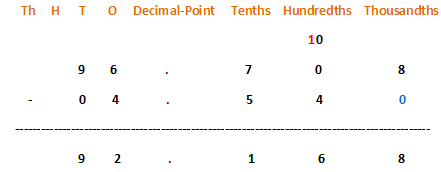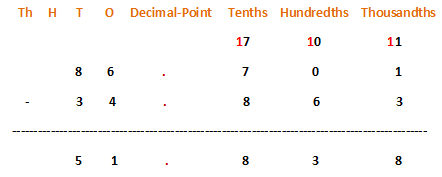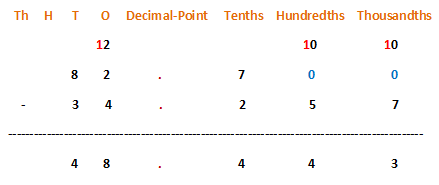CLASS-4
SUBTRACTION OF DECIMALS
SUBTRACTION OF DECIMAL NUMBER -
As we are well aware about the subtraction of digits, similarly we will learn about subtraction of decimals.
There are some simplified example of addition of decimal fraction is given below for your better understanding -
7 3
Example.1) Subtract following decimal fraction ------ - ------
10 10
7 3 7 - 3 4
Ans.) ------ - ------ = -------- = -------
10 10 10 10
=> 0.7 - 0.3 = 0.4
so, required result of subtraction is 0.4 (Ans.)
5 9
Example.2) Subtract following decimal fraction ------- - ------
10 100
Ans.)
5 9 (5 X 10) - 9 41
------ - ------ = -------------- = -------
10 100 100 100
=> 0.5 - 0.09 = (0.50 - 0.09) = 0.41
So, the required result is 0.41 (Ans.)
Principal/Properties Of Decimals -
a) The subtraction of zero (0) from a decimal number is the same decimal number. Example: 52.06 - 0 = 52.06
b) The subtraction of any decimal number from zero (0) is the same decimal number with negative (-) sign. Example: 0 - 12.5 = - 12.5
c) Change of order of decimal numbers change their subtraction value. Example: 4.29 - 15.8 = - 11.51
15.8 - 4.29 = + 11.51
So, 4.29 - 15.8 ≠ 15.8 - 4.29
There are some steps for Addition of Decimal Numbers -
Step.1) Write the numerals in column form one below the other.
Step.2) All the decimal points should be in the same column.
Step.3) Convert into like decimals by adding zeroes.
Step.4) Start subtraction from the thousandths place.
Step.5) If there are, any number of any number places is going to subtract from zero (0), then we suppose to prefix one (1) before zero (0), and then we need to subtract the digit from Ten (10), as a result we need to carry one (1) to the previous decimal places. This process should start from thousandths may continue till last given decimal places.
Example.1) Subtract 4.54 from 96.708
Ans.)
Step.1) Write the numerals in column form one below the other.
Step.2) All the decimal points should be in the same column.
Step.3) Convert into like decimals by adding zeroes.
Step.4) Start subtraction from the thousandths place.

Step.5) In the 'thousandths' place, 8 > 0, we can do the subtraction and the result is 8 thousandths and will be placed at 'thousandths' column.
Step.6) In 'hundredths' column 4 has subtract from zero (0), when 0 < 4, so its not possible. So we will prefix one (1) zero (0) and will consider 10 hundredths instead of zero (0). Now we subtract 4 from 10, and the answer is 6 hundredths and is to be placed at 'hundredths' column.
Step.7) To balance the 'hundredths' column we need to subtract one (1) from 7 tenths and obtained 6 tenths is to be placed at 'tenths' column, now we need to subtract 5 tenths from 6 tenths instead of 7 tenths. The obtained result is 1 tenths and need to place in tenths column.
So, the answer is 92.168 (Ans.)
Example.2) Subtract 34.863 from 86.701
Ans.)
Step.1) Write the numerals in column form one below the other.
Step.2) All the decimal points should be in the same column.
Step.3) Convert into like decimals by adding zeroes.
Step.4) Start subtraction from the thousandths place.

Step.5) In the 'thousandths' place we need to subtract 3 thousandth from 1 thousandths but, 1 < 3, so we can not do the subtraction like this. We need to prefix 1 to 1 thousandths and considered as 11 thousandths and now we can subtract 3 thousandths from 11 thousandths and the result is 8 thousandths and will be placed at 'thousandths' column.
Step.6) To balance thousandths column, we need to add 1 with 6 hundredths and we we need to subtract 7 'hundredths' from zero (0) but 0 < 7, so not possible to subtract. So we need to prefix 1 to zero (0) and to be considered as 10 'hundredths' instead of 0 and now we will subtract 7 hundredths from 10 hundredths and the result is 3 hundredths and to be placed at 'hundredths' column.
Step.7) To balance the 'hundredths' column we need to add one (1) with 8 tenths and obtained 9 tenths is to be placed at 'tenths' column, now we need to subtract 9 tenths from 7 tenths. But, 7 < 9, so to subtraction is not possible. In that case, we need to prefix 1 to 7 tenths and is to be considered as 17 tenths in tenths column. Now we need to subtract 9 tenths from 17 tenths. The obtained result is 8 tenths and need to place in tenths column.
Step.8) In integral part, to balance tenths column we need to subtract 1 from 6 ones and we obtain 5 ones. Now we need to subtract 4 ones from 5 ones and the result is 1 ones and is to be placed ones column.
Step.9) In tens column we need to subtract 3 tens from 8 tens and the result is 5 tens.
So, the result is 51.838 (Ans.)
Example.3) Subtract 34.257 from 82.7
Ans.)
Step.1) Write the numerals in column form one below the other.
Step.2) All the decimal points should be in the same column.
Step.3) Convert into like decimals by adding zeroes.
Step.4) Start subtraction from the thousandths place.

Step.5) In the 'thousandths' place we need to subtract 7 thousandth from 0 but, 0 < 7, so we can not do the subtraction like this. We need to prefix 1 to 0 and considered as 10 thousandths and now we can subtract 7 thousandths from 10 thousandths and the result is 3 thousandths and will be placed at 'thousandths' column.
Step.6) To balance thousandths column, we need to add 1 with 5 hundredths and we we need to subtract 6 'hundredths' from zero (0) but 0 < 6, so not possible to subtract. So we need to prefix 1 to zero (0) and to be considered as 10 'hundredths' instead of 0 and now we will subtract 6 hundredths from 10 hundredths and the result is 4 hundredths and to be placed at 'hundredths' column.
Step.7) To balance the 'hundredths' column we need to add one (1) with 2 tenths and obtained 3 tenths which is to be placed at 'tenths' column, now we need to subtract 3 tenths from 7 tenths. The obtained result is 4 tenths and need to place in tenths column.
Step.8) In integral part, we need to subtract 4 ones from 2 ones, but it is not possible because 2 < 4, so we need to prefix 1 to 2 ones and to be considered as 12 ones. Now we can subtract 4 tens fro 12 tens because 12 > 4. The obtain 8 ones is to be placed at ones column.
Step.9) Now to balance we need to add 1 with 3 tens, and the obtained 4 tens is to be subtracted from 8 tens. Now the result is 4 tens and is to be placed at tens column.
The result is 48.443 (Ans.)